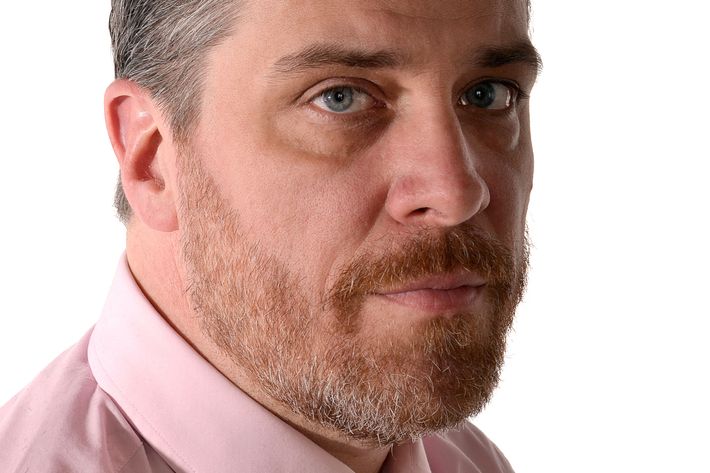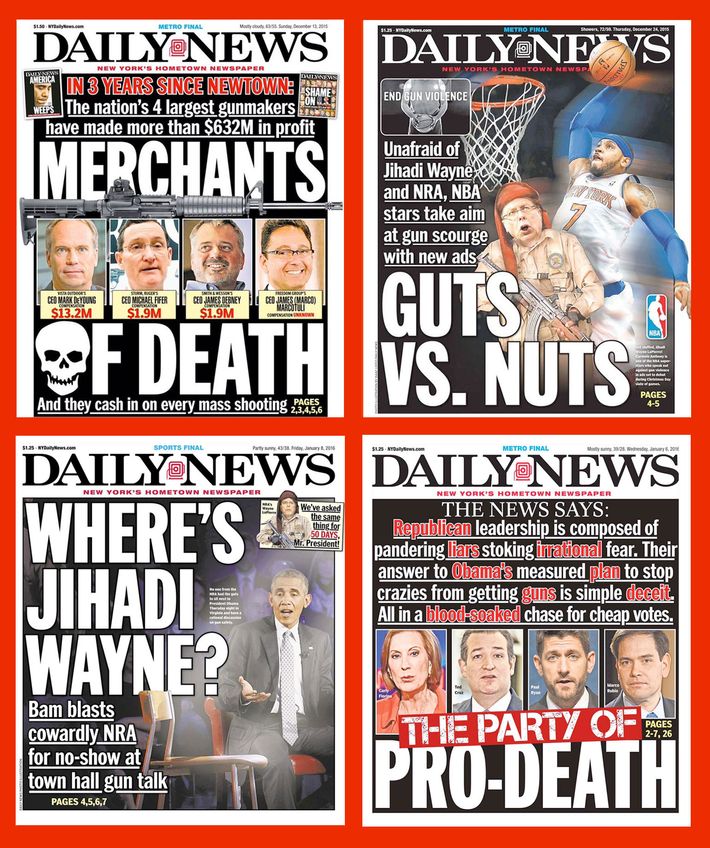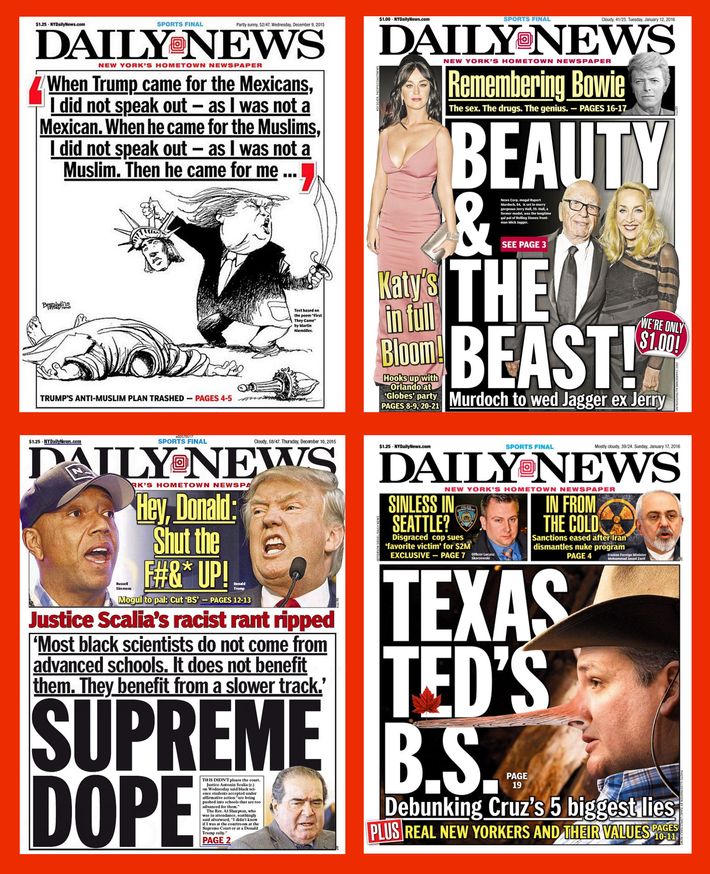
It was past 10 p.m. on January 14 when New York Daily News editor-in-chief Jim Rich received an email from editors at the paper at his home in Park Slope. Earlier editions, with a cover featuring Andrew Cuomo, had already been put to bed. But now they told him that in the midst of the Republican presidential debate — which he hadn’t been watching — Ted Cruz had assailed “New York values” in his attack on Donald Trump.
That morning Rich had reached out to Daily News columnist Mike Lupica about writing on an earlier salvo Cruz had made against the city, suggesting a headline reading “DROP DEAD, TED.” It evoked the famous 1975 Daily News headline “FORD TO CITY: DROP DEAD,” after President Gerald Ford refused a federal bailout for a beleaguered, broke city. Now, with Cruz’s second volley, Rich believed he deserved front-page treatment for the final edition. But how?
He came up with a brash solution: the image of the Statue of Liberty giving the middle finger to Cruz, with the earlier headline, while adding, “Hey, Cruz, You don’t like N.Y. Values? Go back to Canada.”
The image of the front page went viral on Facebook and Twitter, especially among the many people who want to give Cruz the finger anyway.
When Sarah Palin gave her kooky blessing to Donald Trump’s candidacy, the Daily News expressed a different kind of elation: “I’M WITH STUPID!” blared the “wood” on the tabloid’s cover. “Hate minds think alike: Palin endorses Trump.” And the liberal-media elites — more typically Times readers, who, if they dipped into the Daily News at all, turned to it for sports or a hit of gossip — ate it up. Lawrence O’Donnell held it up on his MSNBC show, and Katrina vanden Heuvel, editor and publisher of The Nation, tweeted, “Who’s coming up with NYC’s Daily News tabloid covers? They sizzle.”

That would be Rich, who took charge of the paper last October. It’s still one of the largest-circulation papers in the country. But in the last decade, it, like most dailies, has drastically shrunk in print distribution — and staff size — from more than 500,00 copies on weekdays and Sundays five years ago to 234,000 on weekdays in the third quarter of 2015. Blame all of the usual reasons: advertising and readers moving to the web, with an increasingly fractured audience that seems, at times, impossible to reach.
Last year, the Daily News’ longtime owner, Mortimer Zuckerman, shopped the paper around but by August gave up, unable to find an acceptable buyer for it. And there were more layoffs: After 2013, when the paper parted ways with staffers like columnists Albor Ruiz and Joanna Molloy, last September proved even harsher when the paper let go of dozens of reporters and established bylines, like TV critic David Hinckley and sports columnists Filip Bondy and Bill Madden. Its charismatic editor Colin Myler left, to be replaced by his deputy, Rich. He doubled down on Myler’s emphasis, in the last few years, of publishing to the new digital beat: faster, more national, and increasingly fueled by a certain populist partisan glee.
The latest and most visible manifestation of that new strategic direction is a reinvention of the paper’s “wood” — newsman-speak for page one — for an era of hyperpartisan social sharing. Just as tabloid covers used to amuse, inform, and outrage passersby on the sidewalk, enticing them to pick them up and read all about it, the Daily News has arguably been the most aggressive and successful newspaper brand at turning the old-school institution of a front page into an irresistibly “like”-able image on Facebook — at least for people who don’t care for the right-wing politics of the New York Post. “You’ve seen it with the gun issue; you’ve seen it with Trump,” Rich, 44, explained one afternoon in early January in the paper’s quarters downtown. “We don’t shy away from the controversial issue. You’ve seen publications on the right, but there’s a vacuum on the middle left on these issues, a consistent, strong voice, and I like to think we’re doing a decent job of filling that void.”
Whether this strategy can ultimately help save the storied, humbled paper itself is difficult to know. Newspapers are expensive operations, and it’s still hard to pay the bills with clicks. But at least something is back: the “sizzle.” The paper the Post used to taunt as the “Daily Snooze” has definitely woken up.
In many ways, the covers have been a homage to a time when single-copy sales of the paper meant everything, when the Ford cover reverberated across the city and the world. They really took off in early December, after the San Bernardino attacks, when lines like “GOD ISN’T FIXING THIS,” which took aim at GOP politicians who prayed for the victims, went massively viral, scoring tens of thousands of retweets. Just this month, there was “THE PARTY OF PRO-DEATH,” about the GOP reaction to President Obama’s gun legislation. Or let’s not forget “BEAUTY AND THE BEAST,” which harkened back to the old tabloid wars by making fun of Jerry Hall’s decision to wed Rupert Murdoch, the owner of its longtime rival, the New York Post. The headlines aren’t nuanced, but they aren’t supposed to be.
Not that every one of the headlines has been a home run (the day before the Palin zinger, there was this clunker: “MARTIN LUTHER CRINGE DAY,” critiquing a Reverend Al Sharpton speech). But by capturing the feeling of the day, they’re good for the digital Daily News brand: Now, no matter where they are, these “like”-minded readers can and do add the Daily News to their feeds, which in turn drives traffic back to the website. Meanwhile, within the paper, as one Daily News vet pointed out, “the ballsy covers underscore what’s going on in the newsroom. There’s a bit of frustration there, but also a good-humored sense of resilience among a largely decimated team with nothing to lose.”
And they are helping: In the month that Rich took over, in late October, the Daily News had 32.4 million unique visitors its website, with 132.5 million global views overall, according to Quantcast. These latest figures, ending on January 21, show that number increased to 43.1 million and 149.6 million, respectively.
Rich knows that his job is no longer just about beating the Post on the newsstand. He talks about the Daily News as a “digital first” operation: to be fast and first on as many stories as it can. The paper has become the daily summary of this continuous news operation. And its focus, once relentlessly local — crime, sports, scandal, schools, city politics — has become national.

Rich is doing this with admittedly diminished resources. After years of reducing staff, after the sale didn’t happen in September, the paper reportedly let go of 40 to 50 staffers, including those high-profile reporters like Hinckley, Bondy, and Madden. Even as Rich and I sat in his office in the paper’s headquarters downtown, Politico’s Joe Pompeo reported that the paper had engaged in massive layoffs within its digital team stationed in New Jersey — something neither Rich nor Daily News CEO William Holiber would comment on. Losses have reportedly been estimated between $20 million to $30 million annually; Holiber now says they’re in the “low double digits.”
The Post has had a similarly drastic decline in print circulation, and reportedly loses something like $50 million a year. Amid the Great Recession, Zuckerman and Murdoch even talked about partnering up the papers but couldn’t come to terms.
It takes a tabloid true believer to see hope for this city remaining a two-tabloid town. “It’s not too late,” said Pete Hamill, a former Daily News editor and columnist. “The Daily News and Post gave me my life, and I want to see them survive.” Hamill’s sentiment, of course, speaks to another time, one we can never return to.
But in the meantime, for Arthur Browne, the current editorial-board editor who first joined the Daily News as a copy boy in 1973, Rich fits in with the best editors and “completely understands the paper in terms of serving New York City’s working and middle class. He totally understands the paper’s commitment to this reader. The best editors understand the News’ mission is to make life better for these people.”
Rich gets that for a reason. He grew up in blue-collar Buchanan, a place that’s technically Westchester but has all the industrial trappings of upstate New York. His father worked as a mechanics foreman for the Cortlandt Sanitation Department. There were racks for hunting rifles on the wall. An aborted short stint at Westchester Community College was followed by a directionless stint in South Florida; he worked at a deli and a golf course, and he installed home-security systems.
Eventually, Rich made his way back to Westchester for a communications degree, then did his time at a regional weekly in Eastchester, followed by a stint with the New Britain Herald. He finally arrived at the sports desk at the Post in 2000 at the height of the tabloid wars. It was raucous and comical and mean … and great fun.
Rich left for the Daily News in 2004. His first marriage ended, and he became deeply involved in poker, frequently visiting the now-defunct club Rounders in the Flatiron District. At one point, he decided to quit the Daily News, since his day job was taking away from a more lucrative income in cards. But a promotion — just as the whole poker boom was fading — ended all that.
In 2012, Rich and his third wife, the Post writer Mary Huhn, adopted their son, Altaseb, who is now 8. That same year, in came Colin Myler, the longtime Murdochian who had first met Rich during a stint as executive editor at the Post in the early 2000s. Myler gave the paper a Fleet Street edge again, and began its tilt politically left (especially about guns); he also realized that the tabloid’s traditional strengths — scandal, crime, celebrity — are also values that the new digital-journalism culture values most. The Huffington Post, after all, is basically a web-bred tabloid, and U.K. papers like the Daily Mail and The Guardian have prospered online by moving beyond their metropolitan-area roots (both even have U.S. web editions).
In meetings, the longtime editor Browne took notice of Rich, who represented the sports department. Browne liked Rich’s news sense and felt he had an “excellent tabloid sense of news stories that ranged from the very serious to the very frivolous.”
Myler agreed. Rich was eventually tapped to be executive editor and given oversight of the digital operation, where he served up a frothy mixture of quick news chunks, celebrity gossip, crusading, and opinionated sports coverage.
“New York is national by nature,” Rich said. “It just is, just by the demographic of the population. But that has been one of the more interesting challenges to overcome with people in the newsroom. There’s this constant questioning, ‘Are we the New York Daily News, or are we who we are online?’ Which is clearly nationally driven, just by necessity.”
“You can see from the website that there’s not a New York spin on things,” Hamill said. “The stupidest story leads the website. I’m hardly a prude after 50 years in the business, but the way they present this stuff, they think of the audience as morons most of the time.”
Rich, needless to say, disagrees.
“There are stories that might not end up in the paper because they may not be of as [much] interest to our print readers [as they are] to our digital readers,” he said. “But I always say one doesn’t necessarily take away from one another. We can simultaneously ride both trains and do good work in both.”
Of course, any editor in any so-called legacy outfit will say the same thing. Zuckerman is getting on in years, and it’s not clear who will carry the paper forward into its next century. Still, Rich said, if there ever was a Daily News moment, it might be now.

“It’s a perfect storm,” Rich said. “It’s an election year. We’ve got Donald Trump as one of our candidates. You’ve got the highly emotionally charged issue of guns. You’ve got Barack Obama, because he’s African-American, [he’s] a lightning rod, and you’d be naïve to think that doesn’t play into the resistance he’s gotten from Congress and groups like the NRA.”
“So we have all that in this cauldron, and it’s bubbled up in this stew,” Rich said. “But here’s the way we’re going to present it: It’s going to be loud, in-your-face. And it resonates with people, whether they agree with it or not. If someone wants to call that tabloid journalism, that’s fine. That’s a term that’s evolved into something it never intended to be. I like to call it strong, intelligent journalism.”
And if you just like the wood, you can buy your own framed copies of many of them. Perhaps that’s a new business model for actually selling papers.





























